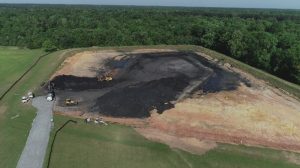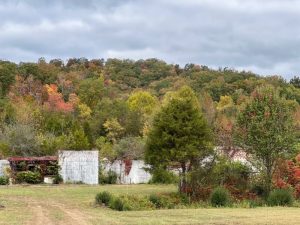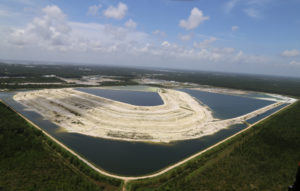American Nuclear Corp Superfund Site
Posted in Project
EPA Region 4 awarded KEMRON Environmental Services a $4.6M task order for the cleanup of the American Nuclear Corporation Superfund Site in Claxton, TN.
KEMRON will profile the waste streams for disposal and/or treatment, excavate contaminated soils on site, and remove irradiated contamination from buildings and structures on site.
Crisp County CCR Pond Closure
Posted in Environmental Restoration, Press Release, Project
KEMRON was contracted by the Crisp County Power Commission to close a coal combustion residuals (CCR) pond in Warwick, Georgia. KEMRON prepared an Erosion Sedimentation and Pollution Control Plan that was submitted to the Local Issuing Authority and approved for a Notice of Intent for construction. Best Management Practice (BMPs) for stormwater management in the form of over 3,000 linear feet of double row silt fencing and a sedimentation basin were installed. KEMRON implemented fugitive dust control in the form of dust suppression by maintaining appropriate moisture levels, dust control by spraying of water as the dryness of the CCR/soil material warranted and Onsite monitoring of dust levels.
 Initially, 10 acres of organic content was removed from the surface material within pond. Once the stripping operations were complete, the area inside the ash pond was prepared inside the pond to spread out wet/saturated CCR and allow it to decant, evaporate, and dry. A blending area and a ready to load out stockpile area was prepared. Onsite paint filter testing was conducted of CCR and blended materials prior to load out and disposal to ensure that material was within compliance for landfilling. Once materials met disposal criteria, they were transported for off-site disposal at the Crisp County MSW landfill. Over 117,000 cubic yards of CCR has been excavated and disposed followed by backfilling over 20,00 cubic yards of clean backfill for site restoration. Project activities included 12,000-man hours without a recordable incident.
Initially, 10 acres of organic content was removed from the surface material within pond. Once the stripping operations were complete, the area inside the ash pond was prepared inside the pond to spread out wet/saturated CCR and allow it to decant, evaporate, and dry. A blending area and a ready to load out stockpile area was prepared. Onsite paint filter testing was conducted of CCR and blended materials prior to load out and disposal to ensure that material was within compliance for landfilling. Once materials met disposal criteria, they were transported for off-site disposal at the Crisp County MSW landfill. Over 117,000 cubic yards of CCR has been excavated and disposed followed by backfilling over 20,00 cubic yards of clean backfill for site restoration. Project activities included 12,000-man hours without a recordable incident.
KEMRON designed and implemented a wastewater treatment system (WWTS) to treat contact water pumped from the ash pond prior to discharge to the Flint River in compliance with Georgia Environmental Protection Division NPDES Discharge Permit. The WWTS consisted of: 42,000-gallon weir/equalization/sludge tanks; 800-gallons per minute suction and discharge pumps; 23 Bag Filtration Units; pH adjustment unit; 42,000-gallon effluent tanks; Coagulant/flocculent mix system; flow meters; static mixer and static mixer injection manifold; and aluminum chloride hydroxide sulfate flocculant mix. Water samples were collected from the effluent sampling point on a weekly basis and from the Flint River and tested. Effluent and instream monitoring results were submitted to the GA EPD through an online submittal system each month following the sampling period in accordance with the NPDES Permit.
Eller Whitlock Landfill Closure
Posted in Construction Services, Project
KEMRON provided turnkey design and construction services under a contract with the Georgia Environmental Protection Division to close the abandoned Eller - Whitlock municipal solid waste landfill, in Brunswick, Georgia. Preliminary activities included a visual inspection of the solid waste landfill surface, side slopes, and adjacent areas for: waste; the condition and type of any cap material; seeps or leachate outbreaks; erosion; drainage pathways; other areas of concern; landfill control features, methane monitoring system and vents, and ground water monitoring wells; and environmentally sensitive natural resources. KEMRON delineated the limits of waste and thickness of in-place cover soils via test pits and borings. Our evaluation resulted in a limit of waste survey and produced accurate legal description of both the waste footprint and property boundary. KEMRON utilized the results of the limit of waste survey to prepare Construction Quality Assurance (CQA)

Plan, Construction Specifications and Closure and Post Closure Care Plan Drawings that outlined the construction of a 24-inch thick final cover system (a 12-inch soil infiltration layer and a 12-inch final soil cover) and included Closure Post Closure Care Construction Drawings. The groundwater and methane monitoring network was inspected in accordance with the Water Well Standards Act for monitoring wells, including an analysis of the location and construction information of all onsite groundwater receptors and delineation of groundwater receptors within one half mile of the landfill property boundary.
KEMRON completed the construction of the 24-inch thick final cover system and prepared an Erosion Sedimentation and Pollution Control Plan. BMPs in the form of 4,000 linear feet of double row silt fencing and a sedimentation basin were installed. KEMRON regraded 16,000 cubic yards of the 10-acre landfill to promote positive drainage and prepare it for the cover system. 42,000 cubic yards of clean backfill material was imported, placed and compacted over the waste mass. Erosion control matting and vegetative cover we placed to complete the project and obtain a notice of completion.
Fort Ord MEC Support SATOC – Unit 5 Update
Posted in Press Release, Project
KEMRON Environmental Services recently started field work on our 3rd task order under our MEC Support SATOC with USACE Sacramento District at the former Fort Ord in Monterey, California. This $2.69 million task order entails the munitions cleanup and soil evaluation in Unit 5. KEMRON is currently conducting manual and mechanical vegetation clearance within the 130-acre unit and will complete surface MEC clearance, digital geophysical mapping, and munitions constituent sampling early in 2022.

KEMRON has been awarded Task Order 03 on our Munitions and Explosives of Concern (MEC) Support Single Award Task Order Contract (SATOC) by the U.S. Army Corps of Engineers, Sacramento District (CESPK) for at the former Fort Ord in Monterey, California. This task order will allow KEMRON to complete the full remediation of Unit 5 in the Impact Area. This award, valued at $2.69 million (without options), is for the munitions cleanup and soil evaluation in this 130-acre unit. KEMRON will field two 7-man UXO teams to complete the surface MEC removal following mechanical mastication of all site vegetation along with manual vegetation removal and limbing. After completion of the surface removal, digital geophysical mapping will then be performed by our long-time partner, NAEVA Geophysics, with direction from AECOM senior geophysicist leadership, followed by a field reconnaissance task under the Basewide Range Assessment program to determine if potential metals and explosives contamination exists in site soils.
Mississippi Phosphates Corporation (MPC) – Pascagoula, MS
Posted in Project
KEMRON was awarded a task order for the remediation of the former Mississippi Phosphates Corporation (MPC) located in Pascagoula, MS. The site has been proposed to the National Priorities List (NPL). MPC began operations in the 1950’s manufacturing fertilizer and eventually expanding to encompass over 1000 acres and includes a phosphoric acid plant, a diammonium phosphate plant, a sulfuric acid plant, and associated storage warehouses. The facility also includes a wastewater treatment plant along with a series of support structures. Material storage areas include two phosphogypsum waste piles (gypstacks) covering over 340 acres and wastewater storage ponds containing over 700 million gallons of low pH wastewater. Contaminants include ammonia as nitrogen, arsenic, cadmium, chromium, copper, lead, nickel, and zinc. Requirements under this task order include operation and maintenance of wastewater storage units, operation and maintenance of the wastewater treatment plant, pond management and repair and maintenance of all associated equipment.
Wastewater treatment and collected storm water treatment activities is conducted in two wastewater treatment plants along with discharge monitoring, and water quality sampling associated with plant operations and permit compliance. The two-wastewater treatment plants include a mechanical treatment system comprised of a double lime treatment process and a second unit referred to as the in situ treatment system comprised of a series of canals where chemical addition is used to adjust pH. KEMRON is treating 1 million gallons per day through the mechanical plant; 4 million gallons per day through the in situ system within the existing canals. KEMRON also conducts all inspections, pond level measurements, and refueling activities associated with pump operations.
Taylor Slough – South Florida Water Management District
Posted in Environmental Restoration, Project
With approval from the Governing Board, the South Florida Water Management District implemented an innovative plan to deliver needed fresh water to Florida Bay. This is an immediate first step to help reduce salinity levels in the bay and promote the recovery of seagrasses killed during a severe drought in 2015, providing critical relief.
The South Florida Water Management District is working to improve undesirable resource conditions in Taylor Slough while maintaining flood mitigation within the C-111 basin. KEMRON was awarded the Taylor Slough/L-31W Levee and Plug Project during the fall of 2016. The project site encompasses approximately 600 acres. The scope of the Taylor Slough/L-31W Levee and Plugs Project is to construct ten (10) earthen plugs at various locations along the L-31W canal, construct a seepage barrier in the S-332D Pump Station Drainage Basin, and modify the gap in the L-31W levee to reduce its width to 500 feet and create a weir at an elevation of + 2 feet.
Former Custom Cleaners
Posted in Project
KEMRON was tasked by the USEPA to respond to a contaminated site in Memphis, TN. The Former Custom Cleaners (FCC) site operated as a laundry or dry cleaner from approximately 1950 until the mid-1990s. In 2013, the Tennessee Department of Environment and Conservation (TDEC) conducted investigation activities that indicated tetrachloroethylene, also known as perchloroethylene (PCE), was used during Custom Cleaners tenure at the site. In March 2015, the EPA supported TDEC Site Inspection (SI) sampling activities at the FCC site that included the collection of subsurface soil samples, soil gas samples, and groundwater samples. Analytical results for samples collected during the Site Investigation indicated the presence of a PCE source.
KEMRON demolished the existing building to allow access to the contaminated soil beneath the structure and surrounding pavement. KEMRON demolished the structure and all concrete paving in the area resulting in 23 truckloads of debris taken to a local subtitle D Landfill for disposal. KEMRON then excavated PCE contaminated soil and staged the material on site in 500 yard piles.
Dewatering Study
Posted in Project
The Applied Technology Group of KEMRON Environmental Services, Inc. (KEMRON) conducted a dewatering laboratory bench scale study on impacted sediment from a river site located in the Boston, Massachusetts area. The purpose of the dewatering study was to evaluate dewatering techniques in order to increase the material percent solids and density for potential disposal. Four site sediments were evaluated during the bench scale study. The sediments showed a variation in particle size distribution from coarse sand to silt and was impacted with Hexavalent Chromium. KEMRON evaluated the effectiveness on the site materials for three different dewatering techniques including Recessed Plate Simulations through the use of Baroid filter press testing, Belt Filter dewatering using a Crown® Belt Filter Press, and GeoTube® dewatering through the use of the GeoTube® Rapid Dewatering Technique (RDT). The study included polymer evaluations as well as evaluating the dewatering technology on the “as received” material and material screened through a #200 sieve (de-sanded).
Perfluorinated compounds (PFCs)
Posted in Project, Treatability Studies and Remedial Technology Evaluation
KEMRON’s Applied Technologies Group performed an ex-situ thermal remediation bench scale treatability study on soil which was impacted with compost impacted with Perfluorinated compounds (PFCs). Common PFCs include perfluorooctanoic acid (PFOA), used to make fluoropolymers such as Teflon, among other applications; or perfluorooctanesulfonic acid (PFOS), used in the semiconductor industry, 3M's former Scotchgard formulation, and 3M's former fire-fighting foam mixture; or perfluorononanoic acid (PFNA), used as surfactant in the emulsion polymerization of fluoropolymers; or perfluorobutanesulfonic acid (PFBS), used as a replacement for PFOS in 3M's reformulated Scotchgard; or perfluorooctanesulfonyl fluoride (POSF), used to make PFOS-based compounds; or perfluorooctanesulfonamide (PFOSA), formerly used in 3M's Scotchgard formulation; and FC-75, a 3M Fluorinert liquid; and perfluorinated cyclic ether (PFCE).
The treatability study was performed to determine the treatment temperatures potentially capable for thermal destruction of PFCs in highly organic soil at the site. The site test material consisted of highly organic soil which had been composted at different decomposing time intervals. Four candidate site materials with decomposition times of 3, 6, 12, and 18 months were subjected to thermal treatment performed at three target temperatures and one retention time. The materials in the study were initially heated to 100 Celsius to completely remove all moisture prior to subjecting the material to the target temperatures of 200, 398, and 1,100 degrees Celsius. Treatment durations were approximately 15 minutes at the target treatment temperature. Throughout treatments KEMRON performed constant temperature monitoring of the soil. All vapors were passed through an activated carbon off-gas treatment prior to releasing into the atmosphere.
KEMRON was not provided with the results of PFC analyses conducted on the treated test materials. However, discussions with the client indicated that treatment temperatures in excess of 1,000C showed successful reductions in total PFC concentrations.


